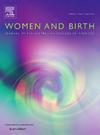葡萄牙助产单位的实施:障碍和促进因素
IF 4.1
2区 医学
Q1 NURSING
引用次数: 0
摘要
在葡萄牙,分娩主要发生在产科病房,即使是低风险妊娠,也常常导致过度的医疗干预。与葡萄牙国家卫生系统相比,成功地纳入卫生系统的助产单位可能是一个可行的替代方案。目的本研究探讨了利益相关者对在葡萄牙实施助产单位的障碍和促进因素的看法。方法采用半结构化访谈法进行定性、描述性、探索性研究。出现了两个主要主题:实施准备情况和实施战略。第一个包括文化、组织、专业和政治层面。第二个重点是葡萄牙助产的专业定位,其与其他医疗保健专业的等级关系,以及卫生系统的结构特征。实施助产单位的主要障碍深深植根于葡萄牙盛行的医生主导的产妇护理模式。然而,国家卫生系统目前面临的挑战,以及正在进行的改革努力,为变革创造了机会。主要的促进因素包括减少不必要的干预措施,促进人性化护理,扩大妇女在分娩中的自主权,并使实践与当代科学证据保持一致。该研究强调,尽管结构性和文化障碍仍然存在,但社会、专业和机构促进者的融合可能为整合葡萄牙助产士护理的连续性提供战略窗口。要将现有证据转化为国家实践,需要有针对性的实施战略、专业间合作和政策宣传。本文章由计算机程序翻译,如有差异,请以英文原文为准。
Implementation of midwifery units in the Portuguese context: Barriers and facilitators
Background
In Portugal, childbirth predominantly occurs in Obstetric Units, even for low-risk pregnancies, often resulting in excessive medical interventions. Midwifery Units, successfully integrated into health systems comparable to the Portuguese National Health System may be a viable alternative.
Aim
This study explores stakeholders’ perceptions of the barriers and facilitators to the implementation of Midwifery Units in Portugal.
Methods
A qualitative, descriptive-exploratory study was conducted using semi-structured interviews for data collection.
Findings
Two overarching themes emerged: implementation readiness and implementation strategies. The first encompasses cultural, organizational, professional, and political dimensions. The second focuses on the professional positioning of midwifery in Portugal, its hierarchical relationship with other healthcare professions, and the structural characteristics of the health system.
Discussion
The primary barriers to implementing Midwifery Units are deeply rooted in the prevailing physician-led maternity care model in Portugal. However, the current challenges within the National Health System, along with ongoing restructuring efforts, create an opportunity for change. Key facilitators include the aim of reducing unnecessary interventions, promoting humanized care, expanding women's autonomy in childbirth, and aligning practices with contemporary scientific evidence.
Conclusion
The study highlights that while structural and cultural barriers persist, a convergence of social, professional, and institutional facilitators may offer a strategic window for integrating Continuity of Midwife Care in Portugal. Tailored implementation strategies, interprofessional collaboration, and policy advocacy are required to translate existing evidence into national practice.
求助全文
通过发布文献求助,成功后即可免费获取论文全文。
去求助
来源期刊

Women and Birth
NURSING-OBSTETRICS & GYNECOLOGY
CiteScore
7.20
自引率
13.20%
发文量
371
审稿时长
27 days
期刊介绍:
Women and Birth is the official journal of the Australian College of Midwives (ACM). It is a midwifery journal that publishes on all matters that affect women and birth, from pre-conceptual counselling, through pregnancy, birth, and the first six weeks postnatal. All papers accepted will draw from and contribute to the relevant contemporary research, policy and/or theoretical literature. We seek research papers, quality assurances papers (with ethical approval) discussion papers, clinical practice papers, case studies and original literature reviews.
Our women-centred focus is inclusive of the family, fetus and newborn, both well and sick, and covers both healthy and complex pregnancies and births. The journal seeks papers that take a woman-centred focus on maternity services, epidemiology, primary health care, reproductive psycho/physiology, midwifery practice, theory, research, education, management and leadership. We also seek relevant papers on maternal mental health and neonatal well-being, natural and complementary therapies, local, national and international policy, management, politics, economics and societal and cultural issues as they affect childbearing women and their families. Topics may include, where appropriate, neonatal care, child and family health, women’s health, related to pregnancy, birth and the postpartum, including lactation. Interprofessional papers relevant to midwifery are welcome. Articles are double blind peer-reviewed, primarily by experts in the field of the submitted work.
 求助内容:
求助内容: 应助结果提醒方式:
应助结果提醒方式:


